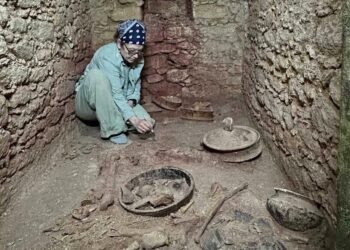Researchers from the Institute of Art at the Polish Academy of Sciences (IS PAN) have unearthed substantial fragments of a 17th-century iconostasis in the attic of St. John the Theologian Church in Nowoberezowo, Podlaskie, Poland. This significant find, considered the oldest of its kind in the region, is hailed for its authenticity and remarkable state of preservation.
The discovery, consisting of 17 fragments, was part of the project titled “Consolidation of Heritage: Inventory and Documentation of Monuments on the western border of the eastern lands of the former Polish-Lithuanian Commonwealth.” Dr. Zbigniew Michalczyk, Piotr Jamski, and Jan Nowicki from the Catalogue of Art Monuments in Poland team made the discovery during their research in the Hajnówka district.
During a recent exhibition in Białystok, the researchers presented photographs and details of the discovered fragments, along with a reconstruction of the entire iconostasis based on archives and the compilation of the found fragments. This presentation was touted as “perhaps the greatest discovery of the Catalogue of Art Monuments in Poland team since El Greco’s painting.”
“From the very beginning, when we realized what we were dealing with, we were convinced that it was extremely important,” Jan Nowicki told Polish news agency PAP. He drew a parallel with the significance of El Greco’s painting, “The Ecstasy of St. Francis,” discovered during the inventory of monuments in Mazovia.
The 17th-century iconostasis stands out not only for its age but also for its originality and untouched state. Nowicki explained, “We are dealing with art that has not been mediated by any conservation, and this is an absolute sensation.” The iconostasis is a complex object, with several preserved icons in varying states, allowing for the reconstruction of almost the entire eight-meter-wide structure.
Dr. Zbigniew Michalczyk highlighted the rarity of such discoveries, mentioning that there are almost no analogies to the Nowoberezowo iconostasis. While small relics of 17th-century modern iconostases exist in Podlaskie, he pointed out that the Nowoberezowo discovery is unparalleled in terms of originality, scale of preservation, and the local context.
The researchers noted that the iconostasis from Nowoberezowo is considered the oldest in the region, as most similar objects from the 17th and 18th centuries in the Russian partition were destroyed in the 19th or 20th century. The discovery’s cultural, historical, and regional significance prompted the researchers to publish preliminary results in the Art History Bulletin.
In summarizing the groundbreaking find, Dr. Zbigniew Michalczyk emphasized, “We have absolutely no doubt that this is a unique discovery. From the very beginning, when we realized what we were dealing with, we were convinced that it was extremely important.”
























